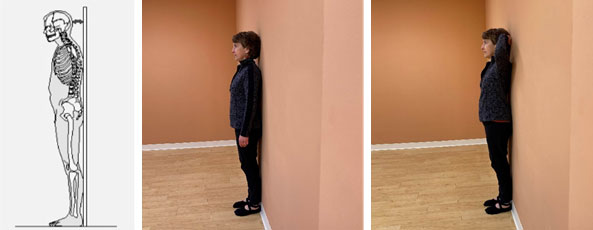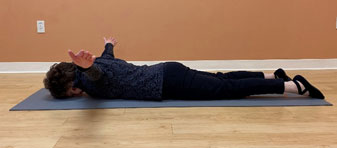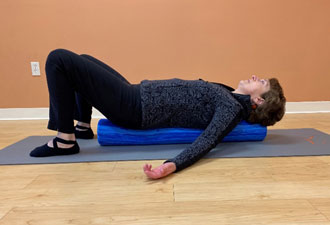If you’ve been diagnosed with osteoporosis or low bone mass, you’ve probably heard that you should avoid bending (or rounding) your spine forward. But do you know why? Let’s do a deeper dive into why posture, particularly as related to your bone health, is so important.
What Is “Good” Posture Anyway?

If you look from the side, our ear-shoulder-outer hip-outer knee-outer ankle should all fall along an imaginary vertical line. This alignment facilitates optimal and beneficial weight bearing forces on our bones. Everything works better when we stand tall, including our breathing and digestion. Researchers from the Netherlands report that posture even plays an important role in recovering from negative moods. (1)
But there’s more.
Anatomy of a Forward Bend and Something Called Bone Creep
The ideal alignment shown in the image above lessens the compressive forces on the vertebra that can occur with poor posture and decreases the risk of injury. But when our head is significantly forward of this vertical line, the shoulders round and the chest drops, all of which creates an increased curve in the upper back.
Bone creep, (yes, it’s a real thing), is a deformation of bone that occurs when bone is subjected to a constant stress over an extended period of time. This, according to Oravec and colleagues, “may play a role in the development of permanent deformity of the vertebrae in vivo* leading to clinically observable spinal fractures.” (2). The images below say it all.

So that’s the bad news.
Now let’s talk about the positive, immediately applicable steps we can take to improve our postural alignment.
#1: Self-check of Your Current Posture
A quick and objective way to do this is with the wall test shown below.
Simply stand against a wall with your heels, buttocks and upper back all touching the wall. Does the back of your head touch the wall without tipping your head back? If so, that’s fantastic. But many people will find that there’s some space there. Use your fingers to measure the distance (i.e., the number of fingers) that are needed to bridge the gap between the back of your head and the wall. Make a mental note of this and recheck yourself from time to time.

#2 Incorporate Back Strengthening Exercies
There are dozens of back exercises that can be done in a variety of positions, (including standing and sitting), but one of my favorites is shown below. I call it the “anti-slouch” exercise, or the “T”.
In a face down position with your arms out to the sides at shoulder level like the letter “T”, raise only your arms, and slowly lower them back to the floor. Start with 10 reps, and gradually progress by adding a hold, or adding more reps. You could take it even further by holding light dumbbells in your hands, but I would not advise using anything heavier than 2 pounds.

#3 Stretch Out the Tight Muscles of the Chest and Shoulders
Again, there are many ways to do this, but I will highlight one that is unusual and one of my favorites. You can use a 36” long foam roller, a pool noodle, or even a tightly rolled up towel. Place the roller lengthwise along your spine, making sure it’s in the center and that your head is supported. Try to ‘let go’, feel the stretch, and just breathe for up to 5 minutes. After this time, slip off the roller and just lie flat on the floor for a few moments noticing the difference you feel along the back of your whole body. This is a wonderful and safe way to self-mobilize your spine and help reduce the excess curve in that you may have in your upper back.

#4 Frequent (and non-judgemental) Self-correcting of Your Posture
This will help establish new habits and continue to build the back strength needed to sustain this closer-to-ideal posture that we’re all striving for. Body awareness is key.
Next month, we’ll continue this theme, and I’ll talk about spine sparing strategies in every day activities.
In the meantime, I hope to see you in Strong Bones class where we regularly focus on ALL of these things as part of our life-long journey together.
Please share this blog and remember to “like it” on facebook.
*In vivo = in the living body
References
1. Veenstra L, et al. Embodied Mood Regulation: The Impact of Body Posture on Mood Recovery, Negative Thoughts, and Mood-congruent Recall. Cognition and Emotion 2017 Nov;31(7):1361-1376.
2. Oravec D, et al. The Relationship of Whole Human Vertebral Body Creep to Geometric, Microstructural, and Material Properties. Journal of Biomechanics 2018; 73:92-98.
